As a joint venture between the chemistry communities of China and the UK, Materials Chemistry Frontiers strives to report the best research from China and rest of the world to international audiences.
 Board members of the journal regularly select and feature their favorite MCF articles that represent research the members see as possessing exceptional novelty and a potential impact to the development of the field.
Board members of the journal regularly select and feature their favorite MCF articles that represent research the members see as possessing exceptional novelty and a potential impact to the development of the field.
This month, Editorial Board member Zhen Li picked his choice articles from those published in Materials Chemistry Frontiers during June and July 2017.
All these articles are now FREE to read.
 @MaterChem on Twitter to tell us how you think about them.
@MaterChem on Twitter to tell us how you think about them.
Design and effective synthesis methods for high-performance polymer semiconductors in organic field-effect transistors
Longxian Shi, Yunlong Guo, Wenping Hu and Yunqi Liu
Mater. Chem. Front., 2017, Advance Article
DOI: 10.1039/C7QM00169J, Review Article
First published on 07 Jul 2017
Editor’s comments:
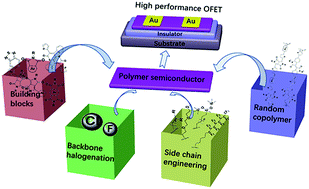 Organic field effect transistors (OFETs), important components of organic electronics, have witnessed lots of breakthrough, partially due to their potential applications in radio frequency identification (RFID) tags, flexible displays, electronic papers, sensor and so forth. Thanks to the advantages of flexibility, light weight, transparency, solution-processability and modifiability, polymer semiconductors are one of the favorite choices for OFETs. In this Review Article, Yunlong Guo, Wenping Hu, and Yunqi Liu and coworkers from Institute of Chemistry, Chinese Academy of Sciences (China) and Tianjing University (China) summarized the progress of the third-generation donor-acceptor (D-A) polymers for OFETs with high performance, especially emphasizing on building block selection, backbone halogenation, side chain engineering and random copolymerization. They pointed out that once the chemical approaches mentioned above are combined with rational device architectures, more high-performance polymer based OFETs are expected.
Organic field effect transistors (OFETs), important components of organic electronics, have witnessed lots of breakthrough, partially due to their potential applications in radio frequency identification (RFID) tags, flexible displays, electronic papers, sensor and so forth. Thanks to the advantages of flexibility, light weight, transparency, solution-processability and modifiability, polymer semiconductors are one of the favorite choices for OFETs. In this Review Article, Yunlong Guo, Wenping Hu, and Yunqi Liu and coworkers from Institute of Chemistry, Chinese Academy of Sciences (China) and Tianjing University (China) summarized the progress of the third-generation donor-acceptor (D-A) polymers for OFETs with high performance, especially emphasizing on building block selection, backbone halogenation, side chain engineering and random copolymerization. They pointed out that once the chemical approaches mentioned above are combined with rational device architectures, more high-performance polymer based OFETs are expected.
Molecular conformation and packing: their critical roles in the emission performance of mechanochromic fluorescence materials
Can Wang and Zhen Li
Mater. Chem. Front., 2017, Advance Article
DOI: 10.1039/C7QM00201G, Review Article
First published on 07 Jun 2017
Editor’s comments:
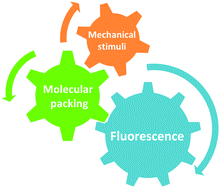 The development of mechanochromic fluorescence (MCF) materials has attracted much attention due to their great potential in data storage, anti-counterfeiting, pressure sensors and display. However, the significantly variety in the origin of this stimuli-responsive systems makes it challenging to establish a general and specific design strategies to create new high-contrast MCF materials. In this Review Article, Zhen Li and co-worker from Wuhan University (China) summarized the mechanisms of different MCF cases from the viewpoint of molecular packing status, intermolecular interactions, and intramolecular conformation in polymorphism MCF systems. The critical roles of molecular packing and conformation in the force-to-luminescence process are discussed. The general thoughts of structure–packing–performance generated from the MCF materials might promote the further optimization of organic material performance in aggregated state.
The development of mechanochromic fluorescence (MCF) materials has attracted much attention due to their great potential in data storage, anti-counterfeiting, pressure sensors and display. However, the significantly variety in the origin of this stimuli-responsive systems makes it challenging to establish a general and specific design strategies to create new high-contrast MCF materials. In this Review Article, Zhen Li and co-worker from Wuhan University (China) summarized the mechanisms of different MCF cases from the viewpoint of molecular packing status, intermolecular interactions, and intramolecular conformation in polymorphism MCF systems. The critical roles of molecular packing and conformation in the force-to-luminescence process are discussed. The general thoughts of structure–packing–performance generated from the MCF materials might promote the further optimization of organic material performance in aggregated state.
High rate Li-ion storage properties of MOF-carbonized derivatives coated on MnO nanowires
Zhen-Dong Huang, Zhen Gong, Qi Kang, Yanwu Fang, Xu-Sheng Yang, Ruiqing Liu, Xiujing Lin, Xiaomiao Feng, Yanwen Ma and Dan Wang
Mater. Chem. Front., 2017, 1, 1975-1981
DOI: 10.1039/C7QM00178A, Research Article
First published on 02 Jun 2017
Editor’s comments:
 The supply of power is one of the most important issues in modern life. Nowadays, lithium-ion batteries (LIBs) are still the leading power sources for electrical vehicles and still predominate in the battery market for portable electronic devices and green energy distribution. To break the limit of traditional LIBs with graphite as the anode material, many efforts have been attempted. In this Article, Yanwen Ma, Dan Wang and coworkers from Nanjing University of Posts & Telecommunications (China) and Institute of Process Engineering Chinese Academy of Sciences (China) utilized zeolitic imidazolate framework (ZIF) types of MOF strung by MnO2 NWs as precursors, to prepare C/Co-coated MnO nanowires (C/Co-MnO NWs), which could deliver 848.4 and 718 mA h g-1 at 500 and 5000 mA g-1 after 40 charge/discharge cycles, respectively, superior to other reported MOF-derived nanostructured materials.
The supply of power is one of the most important issues in modern life. Nowadays, lithium-ion batteries (LIBs) are still the leading power sources for electrical vehicles and still predominate in the battery market for portable electronic devices and green energy distribution. To break the limit of traditional LIBs with graphite as the anode material, many efforts have been attempted. In this Article, Yanwen Ma, Dan Wang and coworkers from Nanjing University of Posts & Telecommunications (China) and Institute of Process Engineering Chinese Academy of Sciences (China) utilized zeolitic imidazolate framework (ZIF) types of MOF strung by MnO2 NWs as precursors, to prepare C/Co-coated MnO nanowires (C/Co-MnO NWs), which could deliver 848.4 and 718 mA h g-1 at 500 and 5000 mA g-1 after 40 charge/discharge cycles, respectively, superior to other reported MOF-derived nanostructured materials.
In situ polymerized hyperbranched polymer reinforced poly(acrylic acid) hydrogels
Nazila Dehbari, Javad Tavakoli, Simranjeet Singh Khatrao and Youhong Tang
Mater. Chem. Front., 2017, 1, 1995-2004
DOI: 10.1039/C7QM00028F, Research Article
First published on 06 Jun 2017
Editor’s comments:
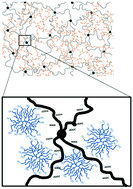 Hydrogels, a special kind of three-dimensional cross-linked, water-swollen and hydrophilic polymers, have been extensively investigated for use in various applications as enviro-sensitive materials. Among various types of hydrogels, polyacrylate polymers such as polyacrylic acid (PAA) have the most versatile structure to enhance their practical utility in everyday life applications such as filtration, water remediation, diapers and hygiene products, cosmetics, wound dressings, medical waste solidification and metal ion removal. However, regardless of many advantages, the poor mechanical property of PAA hydrogels is considered as a marked weakness, and limited their specific applications. In this Article, Youhong Tang and coworkers from Flinders University (Australia) intelligently introduced a hyperbranched polymer into PAA, through in situ polymerization, to toughen PAA hydrogels with 130% improvement in the ultimate tensile strength, without sacrificing the swelling ratio.
Hydrogels, a special kind of three-dimensional cross-linked, water-swollen and hydrophilic polymers, have been extensively investigated for use in various applications as enviro-sensitive materials. Among various types of hydrogels, polyacrylate polymers such as polyacrylic acid (PAA) have the most versatile structure to enhance their practical utility in everyday life applications such as filtration, water remediation, diapers and hygiene products, cosmetics, wound dressings, medical waste solidification and metal ion removal. However, regardless of many advantages, the poor mechanical property of PAA hydrogels is considered as a marked weakness, and limited their specific applications. In this Article, Youhong Tang and coworkers from Flinders University (Australia) intelligently introduced a hyperbranched polymer into PAA, through in situ polymerization, to toughen PAA hydrogels with 130% improvement in the ultimate tensile strength, without sacrificing the swelling ratio.
Highly efficient thermally activated delayed fluorescence materials with reduced efficiency roll-off and low on-set voltages
Haobin Zhao, Zhiheng Wang, Xinyi Cai, Kunkun Liu, Zuozheng He, Xin Liu, Yong Cao and Shi-Jian Su
Mater. Chem. Front., 2017, 1, 2039-2046
DOI: 10.1039/C7QM00195A, Research Article
First published on 13 Jun 2017
Editor’s comments:
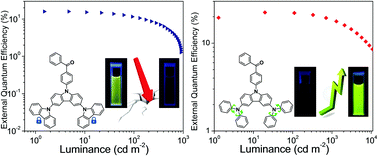 Prompted by both scientific and commercial interests, organic materials with high performance are badly needed to be explored for organic light-emitting diodes (OLEDs). Specially, metal-free thermally activated delayed fluorescence (TADF) materials can achieve 100% use of excitons through reverse intersystem crossing (RISC) because of their low energy gap (DEST) between the lowest singlet excited state (S1) and the triplet excited state (T1). In this Article, Shijian Su, Yong Cao and coworkers from South China University of Technology (China) combined carbazole and two additional carbazole or diphenylamine moieties together with a benzophenone unit, to design two donor–acceptor (D–A) type TADF luminogens of CCDC and CCDD. A maximal EQE of 15.9%, the highest ever value among the reported benzophenone-based blue emitters, was achieved in the blue-emitting devices with CCDC as the emitter. And the green emitting CCDD-based devices demonstrated the maximal EQEs exceed 22% and the on-set voltages of as low as 2.6 V.
Prompted by both scientific and commercial interests, organic materials with high performance are badly needed to be explored for organic light-emitting diodes (OLEDs). Specially, metal-free thermally activated delayed fluorescence (TADF) materials can achieve 100% use of excitons through reverse intersystem crossing (RISC) because of their low energy gap (DEST) between the lowest singlet excited state (S1) and the triplet excited state (T1). In this Article, Shijian Su, Yong Cao and coworkers from South China University of Technology (China) combined carbazole and two additional carbazole or diphenylamine moieties together with a benzophenone unit, to design two donor–acceptor (D–A) type TADF luminogens of CCDC and CCDD. A maximal EQE of 15.9%, the highest ever value among the reported benzophenone-based blue emitters, was achieved in the blue-emitting devices with CCDC as the emitter. And the green emitting CCDD-based devices demonstrated the maximal EQEs exceed 22% and the on-set voltages of as low as 2.6 V.
Morphology control enables thickness-insensitive efficient nonfullerene polymer solar cells
Xiaoyu Liu, Long Ye, Wenchao Zhao, Shaoqing Zhang, Sunsun Li, Gregory M. Su, Cheng Wang, Harald Ade and Jianhui Hou
Mater. Chem. Front., 2017, 1, 2057-2064
DOI: 10.1039/C7QM00182G, Research Article
First published on 22 Jun 2017
Editor’s comments:
 Solution-processed bulk heterojunction (BHJ) polymeric solar cells (PSCs) have attracted extensive attention in the past two decades due to their low cost, light weight, and potential for roll-to-roll production on flexible substrates. Instead of using fullerene acceptors, due to the efforts of scientists, especially the contributions from Xiaowei Zhan’s group (Peking University, China), some PSCs comprising conjugated polymers and non-fullerene acceptors have demonstrated high power-conversion efficiencies (PCE > 12%). So far, one of the major factors hindering industrial production of nonfullerene PSCs is the high sensitivity of the power conversion efficiency (PCE) to thickness variations, which can significantly affect the manufacturing yields and production costs of roll-to-roll processing. When the thickness of the active layer is over 100 nm, PCEs show a significant loss. In this Article, Long Ye, Shaoqing Zhang, Harald Ade and Jianhui Hou from University of Science and Technology Beijing (China), Institute of Chemistry, Chinese Academy of Sciences (China), and North Carolina State University (USA) reported that simply via thermal annealing, highly efficient thickness-insensitive non-fullerene PSCs could fabricated. For example, PBDB-T/IT-M-based nonfullerene PSCs can afford an impressive PCE of up to 9.4% at an active layer thickness of 250 nm, and a high efficiency close to 9%@400 nm, contributing much for the possible commercial roll-to-roll printing technology.
Solution-processed bulk heterojunction (BHJ) polymeric solar cells (PSCs) have attracted extensive attention in the past two decades due to their low cost, light weight, and potential for roll-to-roll production on flexible substrates. Instead of using fullerene acceptors, due to the efforts of scientists, especially the contributions from Xiaowei Zhan’s group (Peking University, China), some PSCs comprising conjugated polymers and non-fullerene acceptors have demonstrated high power-conversion efficiencies (PCE > 12%). So far, one of the major factors hindering industrial production of nonfullerene PSCs is the high sensitivity of the power conversion efficiency (PCE) to thickness variations, which can significantly affect the manufacturing yields and production costs of roll-to-roll processing. When the thickness of the active layer is over 100 nm, PCEs show a significant loss. In this Article, Long Ye, Shaoqing Zhang, Harald Ade and Jianhui Hou from University of Science and Technology Beijing (China), Institute of Chemistry, Chinese Academy of Sciences (China), and North Carolina State University (USA) reported that simply via thermal annealing, highly efficient thickness-insensitive non-fullerene PSCs could fabricated. For example, PBDB-T/IT-M-based nonfullerene PSCs can afford an impressive PCE of up to 9.4% at an active layer thickness of 250 nm, and a high efficiency close to 9%@400 nm, contributing much for the possible commercial roll-to-roll printing technology.
Previous articles recommended by MCF board members are also open for all to access. Read the full collection now!
 Board members of the journal regularly select and feature their favorite MCF articles that represent research the members see as possessing exceptional novelty and a potential impact to the development of the field.
Board members of the journal regularly select and feature their favorite MCF articles that represent research the members see as possessing exceptional novelty and a potential impact to the development of the field.![]() @MaterChem on Twitter to tell us how you think about them.
@MaterChem on Twitter to tell us how you think about them.
















 Board members of the journal regularly select and feature their favorite MCF articles that represent research the members see as possessing exceptional novelty and a potential impact to the development of the field.
Board members of the journal regularly select and feature their favorite MCF articles that represent research the members see as possessing exceptional novelty and a potential impact to the development of the field.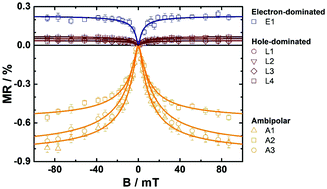 Huge variety of organic semiconductive molecular materials has been reported day-by-day in these years, and the devices based on the materials are mainly of interests with efficient charge transporting properties. The nature of charge carriers themselves, however, has been seldom clarified in many cases. The magnetoresistance in a bipolar semiconductive molecular glass, discussed in the present paper by Reichert, Hagelstein, and Saragi, provides a clear picture of the charge carriers of which spins are in a variety of coupling interactions. The magnetic responses of the devices offer the multi-functional device systems responding external magnetic field, as the authors claim, and will contribute to figure out fundamentally the characters of charge carriers themselves.
Huge variety of organic semiconductive molecular materials has been reported day-by-day in these years, and the devices based on the materials are mainly of interests with efficient charge transporting properties. The nature of charge carriers themselves, however, has been seldom clarified in many cases. The magnetoresistance in a bipolar semiconductive molecular glass, discussed in the present paper by Reichert, Hagelstein, and Saragi, provides a clear picture of the charge carriers of which spins are in a variety of coupling interactions. The magnetic responses of the devices offer the multi-functional device systems responding external magnetic field, as the authors claim, and will contribute to figure out fundamentally the characters of charge carriers themselves.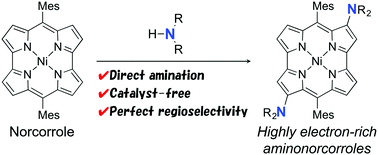 Likely to the aromatic porphyrin derivatives studied widely in everywhere, anti-aromatic norcorroles will be a fundamental and important class of ‘porphyrinoids’ in their condensed phases via p-electron interaction through spaces. The direct amination reactions discovered and demonstrated in the present paper by Yoshida and Shinokubo are very simple approach to functionalize the molecular motifs with region-selectivity via C-H activation. This might be the easiest way to introduce electron donating amino groups into porphynoids, leading to the fine tuning of energy levels with pretty high chemical yields.
Likely to the aromatic porphyrin derivatives studied widely in everywhere, anti-aromatic norcorroles will be a fundamental and important class of ‘porphyrinoids’ in their condensed phases via p-electron interaction through spaces. The direct amination reactions discovered and demonstrated in the present paper by Yoshida and Shinokubo are very simple approach to functionalize the molecular motifs with region-selectivity via C-H activation. This might be the easiest way to introduce electron donating amino groups into porphynoids, leading to the fine tuning of energy levels with pretty high chemical yields.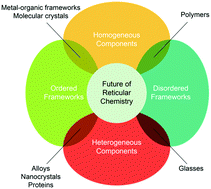 Mater. Chem. Front., 2017, 1, 1304-1309
Mater. Chem. Front., 2017, 1, 1304-1309

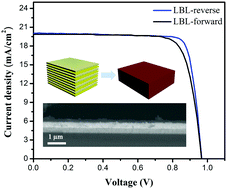
 Editor’s Comments:
Editor’s Comments: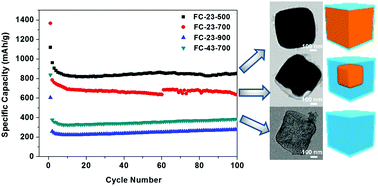 Editor’s comments:
Editor’s comments: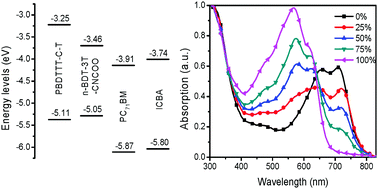 A potential strategy to improve the performance of organic solar cells (OSCs), ternary OSCs based on indene-C60 bisadduct (ICBA) electron acceptor and absorption-complementary electron donors, was reported by Wei and co-workers from National Center for Nanoscience and Technology, China. A high open-circuit voltage of 0.98 V is obtained. The performance of ternary OSCs is improved by 10% attributed to the optimized morphology with better crystalline electron donors and acceptor after blending solution processing small molecules. The reported studies reveal a new method for enhancing the performance of ICBA and non-fullerene based OSCs.
A potential strategy to improve the performance of organic solar cells (OSCs), ternary OSCs based on indene-C60 bisadduct (ICBA) electron acceptor and absorption-complementary electron donors, was reported by Wei and co-workers from National Center for Nanoscience and Technology, China. A high open-circuit voltage of 0.98 V is obtained. The performance of ternary OSCs is improved by 10% attributed to the optimized morphology with better crystalline electron donors and acceptor after blending solution processing small molecules. The reported studies reveal a new method for enhancing the performance of ICBA and non-fullerene based OSCs.
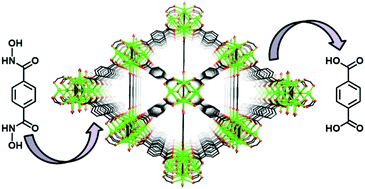 A very powerful approach, solvent-assisted linker exchange (SALE) in metal-organic frameworks (MOFs), was developed in the Hupp and Farha team from Northwestern University, USA. One of the major advantages of SALE is preservation of a MOF topology while introducing a new functionality. The authors demonstrated that SALE could also be applied to increase MOF stability. In particular, increase of stability of widely used UiO-66 framework was reported through incorporation of benzene-1,4-dihydroxamic acid linkers due to formation of stronger bonds. These studies reveal a new avenue in the use of post-synthetic techniques, such as SALE, to access robust metal-organic materials, which is a key component for practical application development.
A very powerful approach, solvent-assisted linker exchange (SALE) in metal-organic frameworks (MOFs), was developed in the Hupp and Farha team from Northwestern University, USA. One of the major advantages of SALE is preservation of a MOF topology while introducing a new functionality. The authors demonstrated that SALE could also be applied to increase MOF stability. In particular, increase of stability of widely used UiO-66 framework was reported through incorporation of benzene-1,4-dihydroxamic acid linkers due to formation of stronger bonds. These studies reveal a new avenue in the use of post-synthetic techniques, such as SALE, to access robust metal-organic materials, which is a key component for practical application development.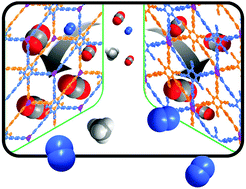 Due to modularity and exceptional tunability, metal-organic frameworks (MOFs) offer a number of advantages for efficient gas separation. Thus, Chen and co-workers from the University of Texas at San Antonio, USA reported the novel MOFs, which selectively adsorb CO2 over CH4 and N2, as shown by single component gas sorption and selectivity calculations. The reported studies are an important step forward for the industrial separation of CO2/CH4 and CO2/N2 gas mixtures as well as a next generation of efficient absorbents.
Due to modularity and exceptional tunability, metal-organic frameworks (MOFs) offer a number of advantages for efficient gas separation. Thus, Chen and co-workers from the University of Texas at San Antonio, USA reported the novel MOFs, which selectively adsorb CO2 over CH4 and N2, as shown by single component gas sorption and selectivity calculations. The reported studies are an important step forward for the industrial separation of CO2/CH4 and CO2/N2 gas mixtures as well as a next generation of efficient absorbents.
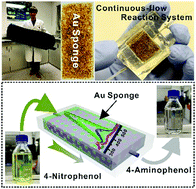
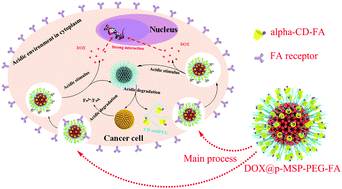
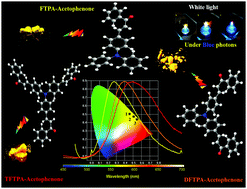 Editor’s Comments:
Editor’s Comments: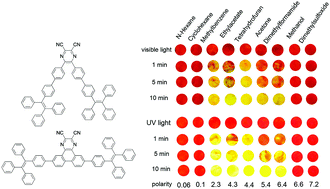
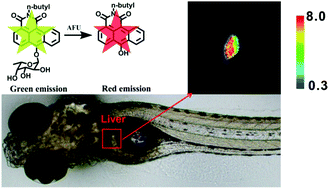 Alpha-ʟ-fucosidase (AFU) is an enzyme that belongs to the family of hydrolases and that plays a vital role in all mammalian cells at low concentrations. Aberrant levels of AFU, however, cause health problems such as fucosidosis and carcinoma. Effective detection of AFU can thus be very useful in terms of early disease diagnosis. F. Zeng, S. Wu and coworkers at South China University of Technology (Guangzhou) presented the first example of ratiometric fluorescent bioprobe for AFU assay. The bioprobe is based on the mechanism of AFU-catalyzed selective cleavage of α-ʟ-fucose group, enabling highly sensitive and selective detection of AFU in live cells. Its detection limit is as low as 0.0033 U mL-1. The researchers successfully applied this bioprobe to a hepatocellular carcinoma model of zebrafish for monitoring and spatially mapping endogenous AFU levels. This work offers an effective approach to studying AFU-associated physiological and pathological processes.
Alpha-ʟ-fucosidase (AFU) is an enzyme that belongs to the family of hydrolases and that plays a vital role in all mammalian cells at low concentrations. Aberrant levels of AFU, however, cause health problems such as fucosidosis and carcinoma. Effective detection of AFU can thus be very useful in terms of early disease diagnosis. F. Zeng, S. Wu and coworkers at South China University of Technology (Guangzhou) presented the first example of ratiometric fluorescent bioprobe for AFU assay. The bioprobe is based on the mechanism of AFU-catalyzed selective cleavage of α-ʟ-fucose group, enabling highly sensitive and selective detection of AFU in live cells. Its detection limit is as low as 0.0033 U mL-1. The researchers successfully applied this bioprobe to a hepatocellular carcinoma model of zebrafish for monitoring and spatially mapping endogenous AFU levels. This work offers an effective approach to studying AFU-associated physiological and pathological processes. Almost all the proteinogenic amino acids are L-stereoisomers in the living systems. Is there any biological implication of this structural motif? A “yes” answer was given in a recent study by Y. Shen, Z. Li and collaborators at Qingdao University of Science and Technology (Shandong) and Institute of Chemistry of Chinese Academy of Sciences (Beijing). The researchers prepared surface-grafted poly(γ-benzyl glutamate) brushes with different secondary structures to investigate the influence of main-chain chirality on cell adhesion behaviours. They found that cells adhered and grown more densely and homogeneously on the poly(γ-benzyl L-glutamate) (PBLG)-grafted surfaces than on those grafted with its enantiomeric counterpart poly(γ-benzyl D-glutamate) (PBDG). This is possibly owing to the chirality recognition of living cells through the stereospecific interactions between the chiral molecules and the cell surface proteins. This study may help better understand cell/chirality interactions.
Almost all the proteinogenic amino acids are L-stereoisomers in the living systems. Is there any biological implication of this structural motif? A “yes” answer was given in a recent study by Y. Shen, Z. Li and collaborators at Qingdao University of Science and Technology (Shandong) and Institute of Chemistry of Chinese Academy of Sciences (Beijing). The researchers prepared surface-grafted poly(γ-benzyl glutamate) brushes with different secondary structures to investigate the influence of main-chain chirality on cell adhesion behaviours. They found that cells adhered and grown more densely and homogeneously on the poly(γ-benzyl L-glutamate) (PBLG)-grafted surfaces than on those grafted with its enantiomeric counterpart poly(γ-benzyl D-glutamate) (PBDG). This is possibly owing to the chirality recognition of living cells through the stereospecific interactions between the chiral molecules and the cell surface proteins. This study may help better understand cell/chirality interactions.